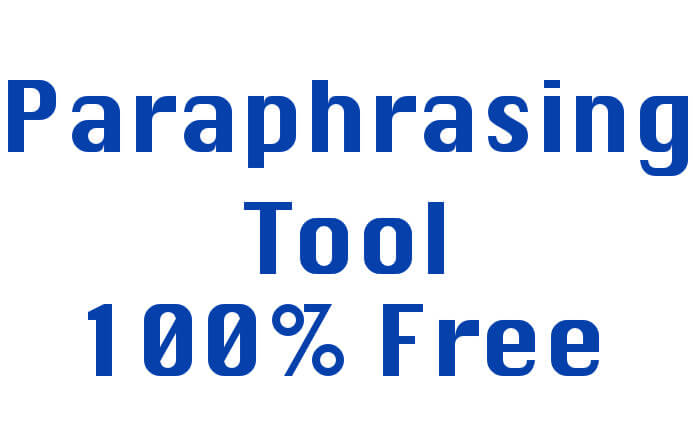How to Use Paraphrasing Tool for Your Academic Work
There are three ways to incorporate the work of other authors into your own writing: cite, use of paraphrasing tool, and summarize. If you take a writing course, you may be asked to use all three. This is an important aspect of any document that you (and your teacher) want you to master. This article will discuss the how to use paraphrase tool in your articles.
First, let’s discuss what plagiarism is;
Plagiarism or copying somebody else’s work and claiming it to be your own is illegal worldwide. Cheats are violating copyright and by placing plagiarized work on another’s website they are putting the site owners at risk. I know that some article directory and opinion site owners have been threatened with the law for unknowingly accepting plagiarized work.
It is quite easy to spot most plagiarized work if you know what to look for, and once you have suspicions Google or CopyScape usually does the rest. As a directory owner I get hacked off with the amount of my time wasted checking suspicious articles when I could be working on improving my business.
Differences Between Paraphrasing and Summarizing
Using quotes is the most common way to include research in your article. Direct quotes should be identical to the original, with a narrow segment of the source. They must correspond verbatim with the source document and must be attributed to the original author.
Paraphrasing, on the other hand, involves putting a passage from the source material into your own words. A paraphrase must also be attributed to the original source.
Paraphrasing tool is a system that helps your interpretation of the essential information and ideas expressed by someone else, presented in a new form. paraphrasing tool are legitimate way (if accompanied by accurate documentation) to borrow from a source. The project topic.org paraphrase tool is a more detailed reassignment, which focuses on one main idea of your content.
All You Need to Know About Paraphrase Tools
here’s a look at some things you may not know about paraphrase and using paraphrasing tools.
Correct reference
You need to reference your text correctly and make sure you give the author credit. So, if you use our paraphrasing tools to paraphrase an article, indicate the source of the article, the author’s name and the publication as the website correctly.
Ideas
You cannot copy an idea and declare it as your own. You can of course add your own ideas to an article, and this is something that is expected of a good writer. When it comes to using paraphrasing tools, it helps you fix alternative words. In no case may the original words of the original article be copied. If you copy it, it will amount to plagiarism.
Formation of sense
The formation of the sentences and the words used must be completely different. You must change not only the words but the very paragraphs. However, you need to make sure the meaning stays the same.
Understand what is needed
As a writer, you must understand that paraphrasing is an important art that you must master. The paraphrase says something about your language proficiency and your abilities regarding your knowledge of the language. If you are a good writer, you can look the same as the author said in a newer way. This is the reason why many students also need to summarize the texts in the school exam – this helps the teacher to know how good it is to understand and understand the text and the language.
Choosing a paraphrasing tool?
A projecttopics.org, a dominant key question asked by MA and PhD students and academics is how to find our academic paraphrasing tools and how to use this services.
This question is sometimes asked after a disappointing experience they had, after choosing the wrong provider of paraphrasing tools or spinbot.
Beyond their need for proofreading services, academics and postgraduate students often have to cite a source or refer to a citation from another author in their research work, and here it is a risk of plagiarism if they simply copy and paste. They must use the frame in their own words and style, with different words and structure, while conveying the intended original idea.
It is completely understandable that things sometimes go wrong for some students and academics who need a paraphrasing tool.
First: poor choice
The first and foremost mistake is simply choosing the wrong service provider. They could be offended by any flourishing and prosperous language these providers have used in their description of their services.
Second: failure of comparison
Almost all projecttopics.org offers customers, especially new ones, a free sample option. In principle, any student or academic who wants to make the right choice should benefit from this offer.
The more samples you get at projecttopics.org, the better it will be, as it will help you compare them all against a certain number of criteria (quality, speed).
Third: source of the problem
The poor quality of paraphrase services is certainly the result of a lack of knowledge about the art of paraphrase.
Paraphrasing is not about replacing one word with another or replacing one sentence with another with synonyms. It is more a matter of fully understanding the original text, deepening it and then converting it with a different style, structure, terminology and tone.
Unfortunately, many students and academics complain that the providers they visited gave them a paraphrased version that was easily discovered was plagiarism. Discovering up or down plagiarized content has never been easier, thanks to available software such as Turnitin.
Thus, it is highly recommended that students and academics in search of a professional paraphrase service research your best provider, test as many providers as possible and then compare the quality of their service. Only you can be sure that you made the right choice.
You don’t have to do it alone
Try this Paraphrasing Tool:

